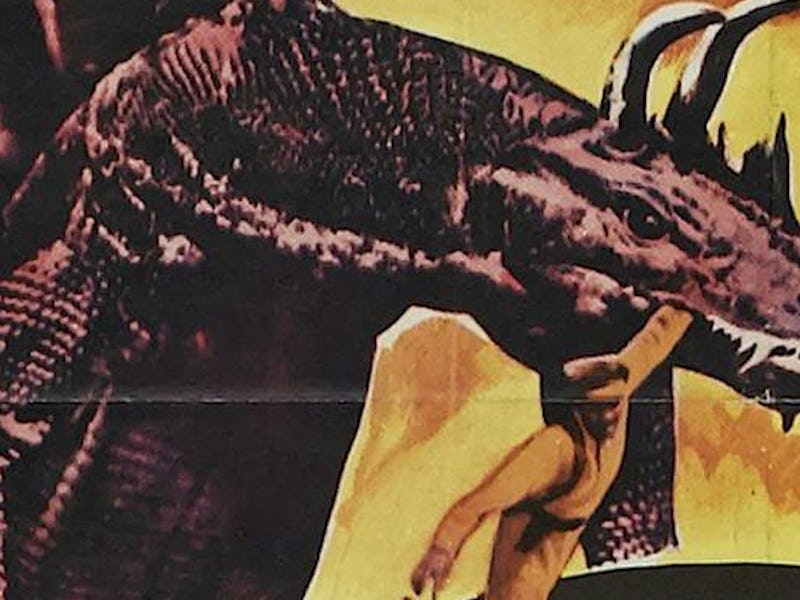65 Years Ago, One Ambitious Sci-Fi Reboot Was Murdered By A Fatal Flaw
How could a silent movie from 1925 beat Irwin Allen in 1960?

On July 13, 1960, before he made Lost in Space in 1965, and well before his legendary 1970s films, The Poseidon Adventure and The Towering Inferno, director Irwin Allen dropped a sci-fi epic that, in theory, set the template for an entire subgenre. As an adaptation of Sir Arthur Conan Doyle’s 1912 novel, The Lost World, Allen’s film imagined a collision of living dinosaurs with modern-day humans. The title is so iconic and memorable that Michael Crichton borrowed it wholesale for his 1995 book sequel to Jurassic Park, which later became the 1997 film of the same name. And, of all the movie versions of The Lost World, outside of the Jurassic Park sequel, the 1960 version is the most visible and best known. But, despite all the charm of the film, it has one fatal flaw that renders it inferior to the dino-romps that it followed and preceded.
To paraphrase Ian Malcolm in the original 1993 Jurassic Park: You were planning on having dinosaurs in your dinosaur movie, right? Quite simply, there are no recognizable dinosaurs in the 1960 version of The Lost World, rendering this flick a bizarre oddity in sci-fi cinema. Somehow, the visual effects of a 1925 silent film version are, to this day, better. Mild spoilers ahead.
The Lost World more or less follows the plot of the Doyle novel: The eccentric Professor Challenger claims to have discovered a hidden plateau in which creatures from the Jurassic Period of the Mesozoic Era still live and thrive. Lacking proof, Challenger (Claude Rains) invites a reporter (David Hedison), a rival zoologist (Richard Haydn), a big-game hunter (Michael Rennie), and a newspaper heiress (Jill St. John) on an expedition to find the dinosaurs. As in the novel, chaos ensues. But what Allen was unable to do was to get any stop-motion dinosaur models in the movie, which means, when our intrepid group of humans enters the eponymous lost world, we are instead faced with what are obviously modern-day lizards with strange horns attached to their bodies. Were anyone’s pet iguanas harmed in the making of The Lost World? Probably. But the real problem is that even in 1960, nobody would think these were actual dinosaurs.
Initially, Allen wanted legendary stop-motion effects artist Willis O’Brien to work on the movie, but because of budget constraints, he had to use live lizards instead. VFX buffs will remember that O’Brien is the visionary who not only did the incredible creature effects for King Kong (1933), but also created stop-motion dinosaurs for the 1925 silent movie version of The Lost World, directed by Harry O. Hoyt. That classic, grainy, black-and-white film features an incredible Allosaurus, Triceratops, and, very memorably, a Brontosaurus that gets loose in London. (Again, this predates King Kong and the 1997 Jurassic Park sequel.) Nothing like that happens on screen in the 1960 version, and the dinosaurs are anything but cool.
A Brontosaurus in the 1925 Lost World versus whatever this is supposed to be in the 1960 version.
The 1960 Lost World has a climax closer to the original book insofar as it doesn’t feature any dinosaurs coming back to a big city and running amok. Instead, there is more of a Temple of Doom vibe in the movie, with the so-called dinosaurs playing second fiddle to the human actors and a ton of very Technicolor lava.
Despite a decent cast, the 1960 Lost World leans into intentional camp in a way that the novel and 1925 version do not. Instead of Professor Challenger existing as a 40-something badass in the vein of Allan Quatermain (King Solomon's Mines, et al.), actor Claude Rains plays him instead as an elderly slapstick weirdo, who now feels more at home in a spoof movie than a sci-fi adventure film. This makes big-game hunter Roxton (Michael Rennie, famous for The Day the Earth Stood Still) the default cool guy, at least in theory. But, it’s actually David Hedison (future two-time Felix Leiter in the James Bond franchise) who serves as the audience surrogate and most likable protagonist in the form of hapless reporter Ed Malone.
However, most of the characters are beset with a series of running gags that turn much of the drama into something that resembles a Looney Tunes situation. (Malone sneezes a lot, Challenger puts a lit cigar into a coat pocket at one point.) All of this would be fine because, as any fan of old monster movies knows, the humans aren’t the main event; it’s all about the creatures. (This is why we put up with dull, squabbling leading men in The Creature from the Black Lagoon, for example.)
What dinosaur is this again?
But the 1960 Lost World fails to deliver on what should be its saving grace. Because the dinosaurs are so unconvincing (by 1960s standards or 2025 standards), the film lacks the wow factor of its silent film antecedent. Had Doyle lived to see the 1960 version, he certainly would have been outraged. And, had this been the only colorful, over-the-top film that Irwin Allen ever made, he would have become a footnote in sci-fi cinema history.
Luckily, most of Allen’s best work (again, Lost in Space!) was ahead of him. Today, The Lost World is fun, to be sure, but it’s also probably best if this cinematic dinosaur remains unearthed, while the skeleton of the 1925 Lost World should be rediscovered and considered the truest and best version to date.